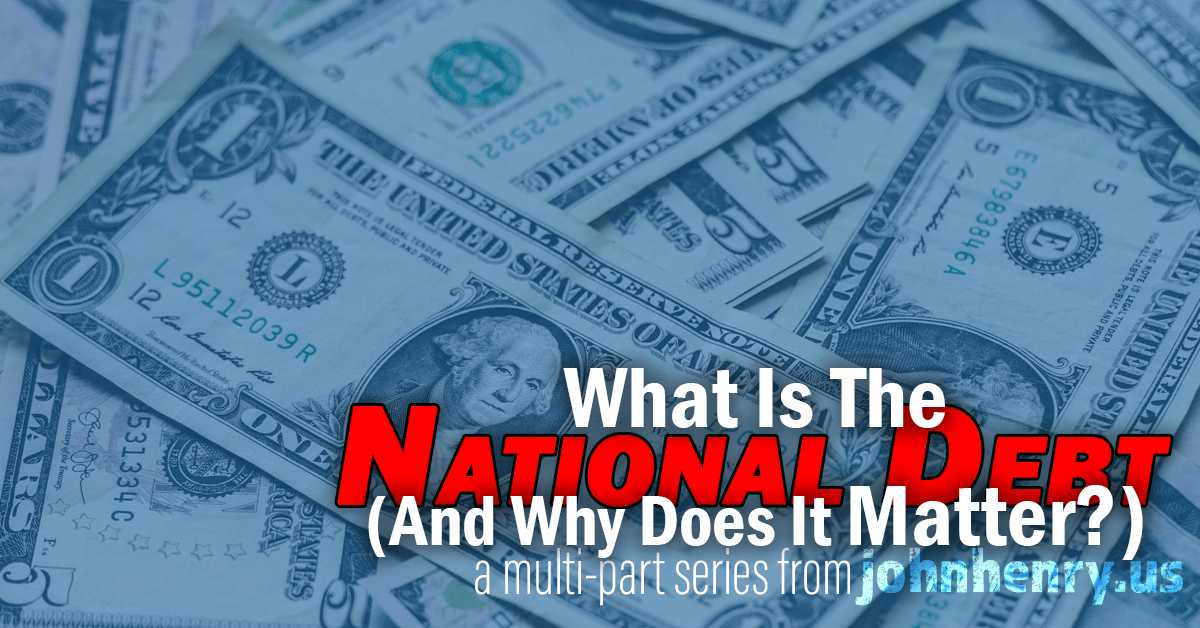The Gold Standard
In part one of our series on the National Debt, we discussed what “debt” is and why in spite of well-intended contradiction the fact is that the “national debt” is a real thing and it has real meaning, just not at all the meaning we’re sold in political rhetoric.
We left off with a brief note about the gradual decoupling of the US dollar from the value of gold, beginning with FDR’s expansion of the dollar in 1933. Remember, our core purpose here is discussing debt, specifically the “national debt,” with additional necessary examination of concept of value and trade.
I don’t want to get into the weeds on side details or a bulleted list of dates, but once upon a time the US dollar was backed – that is to say, its value was derived from – a quantity of gold bullion held, physically, by the United States Government. That’s why the legendary vault at Fort Knox exists. This was known as the “gold standard,” and for centuries was the basis of money everywhere – how much gold (and other precious metals like silver and copper) did the issuer of the money have on hand?
Moving off the gold standard unfortunately started making the picture of what money “is” less clear to the average person, because the dollar was no longer backed by a tangible object. “But,” you exclaim, “it must be backed by something!” You are both right, and wrong. An important part of the wrongness is the belief that “it must be backed by something real, tangible, and with uniquely and objectively identifiable intrinsic value.“
Modern currency is backed by “the full faith and credit” of the issuer. In the US (and with some variability in any other sovereign currency system) that amounts to our GDP (gross domestic product: the sum total of value of all the holdings, goods, services, labor force, etc. created or held by a nation during a given period; if no period is given this is typically one year) plus whatever value is attached to expectations of future stability and growth.
You’re not imagining things: this is a highly speculative and complicated series of educated guesses derived from abstruse calculations of arcane data to the point some would say it’s entirely made up
They wouldn’t be wrong, but you’re also getting out of economics and into metaphysics at that point because the intrinsic value of gold is also “made up,” in the sense that human beings designated it valuable due to its properties which are useful to humans, e.g. not being prone to deteriorating through oxidation the way iron is, being easy to alloy, and being both malleable and attractive enough to work into fine art including coinage. Best not to let yourself get too deep in the weeds on what’s “made up” when you’re talking money. (If you think coinage isn’t fine art, take a good look at a nice new one through a jeweler’s loupe sometime.)
The simple fact is, all modern money is created in this way: out of thin air, at will, by the owner of that currency denomination – US dollars, British pounds, Japanese Yen, etc. Nothing more than the individual integrity of the people running the systems stops any sovereign currency issuer from simply printing the money to pay off their debts.
What induces them to maintain integrity is the impact that would have on the value of their currency and the trust placed in them by international trading partners who would be loathe to exchange goods and services with a partner known for either refusing to pay their debts or intentionally doing so in such a way that the essential value of the debt is seriously lowered. If I agree to buy your EU beef for $10US when $1 = 1 euro, but then when I pay you off $1 = .5 euro because I (as the US) arbitrarily decided to double my dollar supply thereby devaluing each dollar by half but not changing the dollar amount of our contract, you’ve lost half the EU money you thought you were going to have even though you have the same amount of dollars you expected. That’s dumb business, nobody wants to risk that.

The Eurozone
A Different Feather Of Fish
The Eurozone is a bit of a strange duck that I frankly don’t have my head entirely around yet, but as nearly as I can tell for lay purposes one may think of the European Central Bank as being analogous to our Federal Reserve, with member EU states being similar to US states albeit with more sovereign power due to the EU being a confederation of previously existing nation-states rather than one large nation consisting of new subdivision states as US history imagines to be its own case. (In reality of course there were dozens of existing nation-states on the continent before Europeans arrived, and they were subjugated and dislocated by the Europeans for the sake of American expansion westward.)
“Germany” doesn’t print its own money but “Europe” does, and “Germany” is a participating constituent part of “Europe.” I frankly don’t know how this works out in the interplay of how “your taxpayer euros are spent” – in the US at the federal level that’s a null string because “your taxpayer dollars” are never “spent,” they’re destroyed. I assume the Eurozone has a similar overarching taxation system for the same purposes of pulling Euros back out of the system, but I don’t know how that breaks down into e.g. federal infrastructure funding in the Netherlands.
The Guardrails
Each sovereign system has its own checks and balances to forestall bad actors. In the US, for instance, Section 4 of the 14th Amendment to the Constitution reads: “The validity of the public debt of the United States, authorized by law, including debts incurred for payment of pensions and bounties for services in suppressing insurrection or rebellion, shall not be questioned.”
For the record, yes this means the entire concept of a debt ceiling is unconstitutional the moment that ceiling attempts to deny the validity of a public debt, which it does the moment it refuses to account for and settle any given debt. As that is precisely the purpose of a “debt ceiling,” it simply can’t exist constitutionally, but it does because it was originally implemented in 1917 and we didn’t have the proper information and experience to say “hey wait a minute, isn’t this the whole reason we’ve got a set of rules about these things? These rules, right here, the ones you’re egregiously violating?” The purpose of the debt ceiling as conceived is entirely obsolete and shouldn’t have been allowed in the first place.
Additionally, it means all the games the Republicans play with refusing to sign off on the funding to pay the debt until they get the draconian social program cuts they want are also unconstitutional; they legally don’t have a chip on the felt. Yet this has been the operating dynamic of federal budget negotiations for at least half a century, long after the reasons for the original creation of a “debt ceiling” in 1917 were obsolete by our decoupling completely from gold in 1971 (Richard Nixon finalized what FDR started).
Thus the underlying purpose of this series: to help you understand the extent to which this entire “debt ceiling” argument is nonsense, but also to fill that vacuum created in your fact library by the removal of that nonsense with information that’s accurate and useful instead.
Also accurate and useful, ridding yourself of the notion that “central bankers” and “capitalists” are the same creatures. Believe it or not, the space most “central bankers” inhabit is at a computer staring at miles of data and doing their honest best to make sense of it, not some cigar-chomping back room where odious industrialists plot ways to rob people of their labor and freedom.
That’s not to say such rooms don’t exist, but that’s not generally where you find a central banker; you find them poring over spreadsheets trying to figure out exactly what percentage of the currency we’ve sent out needs to come back in order to avoid devaluation while also ensuring there’s enough money circulating for people to live and do business.
The influences of capitalism and corruption tend to be external; economists and macroeconomists (for the most part *cough* Friedman) love math and numbers and statistical trends, and tend to keep their ideology and work separated to avoid one unduly influencing the other. That’s not to say they don’t have beliefs, but like a doctor (a real one, not one in Florida) or journalist as a professional matter they must be able to set those beliefs aside and deal with manifest facts which contradict those beliefs, when such facts arise.
It’s a science, speculative and diaphanous as it may seem from the outside…and the numbers work the same regardless of whether the dollars are capitalist dollars or communist rubles or anything else; sovereign currencies have observable behavioral tendencies which are predictable and are only reliant on ideological influence to the extent that influencers motivated by ideology attempt to disrupt the existing “natural” tendencies of money flow.
This all adds up to a picture of modern economics in which a great deal of energy is expended determining just what the fair value of the “full faith and credit” of a nation really is, when denominated in currency, and those calculations, performed internally and reflecting among other things similar calculations based on known data relevant to other currencies from an “external” standpoint, constitute the guideposts for a central bank as to how much money they can safely create without risking devaluation (or having to raise taxes to avoid that risk) which functionally translates into inflation.
All of this, balanced against the behavior and predictability and stability of several dozen other currencies all denominating the same core “values” (e.g. “the consumer price of a loaf of bread”) in ways that are culturally localized.
It’s an act of juggling cats balanced on crystal wine glasses. A third of the cats are invisible and may be made of razor blades, a couple of them are marmosets, one appears to be a previously undocumented mating of a dachshund and a mountain goat, and you have an eyepatch on one side and the opposite hand tied behind your back.
That, my beloved assembled guests, is what we call “macroeconomics.”
In Part 3, we’ll talk more about that phrase “full faith and credit” and the nature of those cats!










